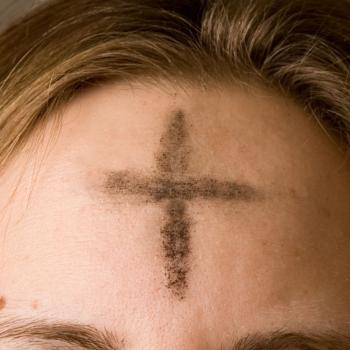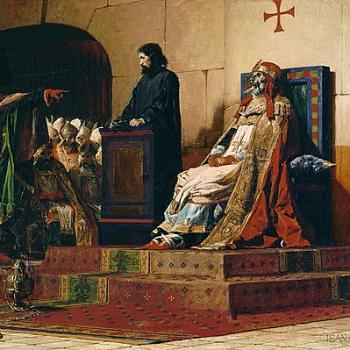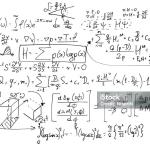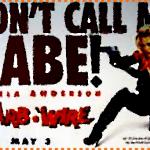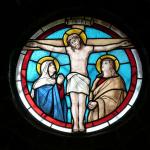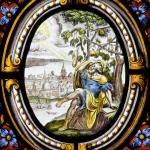Here’s a little excerpt from Mary, Mother of the Son (which will be available from Marytown Press soon and very soon), addressing the peculiar notion that all contact between the Catholic faith and paganism can only mean that Catholic faith is “corrupted”:
We Three Kings of Orient Are /Astrologers Who Traverse Afar
As a young Evangelical, one of the things I routinely heard from critics of Christianity was that “everybody knows” the story of the Magi in Matthew 2 is a pious fiction invented by the Evangelist. Since Evangelicals take a very high view of Scripture and believe (like the Catholic Church) that “Scripture must be acknowledged as teaching solidly, faithfully and without error that truth which God wanted put into sacred writings for the sake of salvation,”[1] it mattered to me whether Scripture was preserving truth or was just a bunch of legends. And since my first investigation, subsequent reading has only added to my conviction that there are ample historical grounds for the story of the Magi.
First—and often overlooked by moderns who have an irrational prejudice against treating Scripture as one source of ancient historical testimony—is Matthew 2 itself, which says “wise men (Greek: magoi) from the East” appeared in Jerusalem one day, seeking “he who has been born king of the Jews.” They claimed to have “seen his star in the East” and came to worship him. Matthew tells us they brought gold, frankincense, and myrrh as gifts and that their visit provoked the paranoid Herod to kill all the boys in Bethlehem under two years old. Matthew also notes they returned to their own country in secret after having been warned in a dream not to return to Herod.
Not that there’s no hint of legend attaching to the Magi, of course. Matthew doesn’t tell us how many Magi there were, nor does he claim any of them were royalty. So how did they attain their legendary crowns and fixed number of three?
The number part is pretty easy: three gifts, three magi. Also, as Christians reflected on their significance as the first Gentiles to worship Jesus, it was natural to connect the Magi with the three biblical races of human beings descending from the sons of Noah, Shem, Ham and Japheth—and thus representing all of humanity.
As to their alleged royalty, this is more complicated. Beyond the biblical record, there is other evidence about them.[2] The historical magoi appear to have been a priestly caste in eastern lands. The Greek historian Herodotus tells us Magi were the sacred caste of the Medes.[3] And Jeremiah refers to one of these eastern priestly figures, a Nergal Sharezar, as Rab-Mag, “Chief Magus” (Jer. 39:3, 39:13). Magi had long been involved in the various religious and political struggles of Persia and their influence continued through the Assyrian, Babylonian, Persian, and Parthian empires. By the time of Jesus, they had long provided priests for Persia and been a major religious influence in the region. One ancient writer named Strabo says Magian priests formed one of the two councils of the Parthian Empire.[4]
Magoi is, of course, related to our English word “magic” but it’s not really accurate to speak of Magi as “magicians.” They lived in an age which hadn’t yet distinguished between the attempt to understand and control nature by what we now call “science” and the attempt to understand and control nature by what we now call “magic.” So we might say the Magi practiced the rudiments of astronomy and the rudiments of astrology.
Precisely what star they saw, and whether it was a natural or supernatural event, we do not know. We do know Jupiter conjoined Saturn three times in seven months in 7 b.c. We also know Mars joined them and produced a very striking configuration at about that time. Further, there’s some speculation that the Star of Bethlehem may have been an occultation of Jupiter by the moon that occurred in 6 b.c., with the royal planet dramatically re-emerging from behind the moon. We even have an ancient Chinese chronicle, the Ch’ien-han-shu, which states that an object, probably a nova, or new star, was observed in March in 5 b.c. and remained visible for 70 days.[5]
Evangelicals who assume that any contact between biblical and pagan beliefs can only lead to corruption of biblical teaching should note that there’s very good reason to think the Magi’s beliefs were a mix of Persian astrology and messianic ideas floating around their country, courtesy of the significant Jewish population that had lived there since the days of Nebuchadnezzar, five centuries before. An American culture that’s quite familiar with Fiddler on the Roof or the tales of Isaac Bashevis Singer should not marvel that, after 500 years, stories far more sacred to the Jews than these folk tales would be widely known among the educated elite in Persia. And a Magian knowledge of sacred Jewish texts certainly fits with Herod’s behavior in slaughtering the innocents of Bethlehem.
Some critics have found this story of Herod’s brutality absurd. Yet we know from non-biblical sources that Herod was indeed profoundly paranoid about rivals to his throne. He had his own children put to death to protect it (whereupon Augustus, who had granted Herod his puppet kingdom, remarked that since Herod observed kosher laws to placate his Jewish subjects, “It is better to be Herod’s pig than Herod’s son”[6]). But beyond this psychological evidence, there is in Scripture itself a tantalizing suggestion about why Herod would react so ferociously to the news of a newborn “king of the Jews”—a reason that dovetails remarkably well with what we know of the Magi.
You see, Herod—the “king of the Jews”—was not a Jew. He was an Edomite, or Idumaean, as they had become known by the time of Christ.[7] Edomites were descendants of Esau, Jacob’s brother. Jacob, you will recall, received the blessing and birthright from Isaac that Esau was supposed to get (Gen. 27). From that time on, rivalry existed between the brothers (and their descendants). Centuries after Jacob and Esau, when Israel escaped from Egypt and was journeying to the Promised Land, Moses requested passage through the land of the Moabites (a people closely allied with the Edomites) and was refused. In fact, the Moabites tried to destroy Israel. As part of their plan, the Moabite king, Balak, hired Balaam the prophet to curse Israel (Num. 22–24). However, as hard as Balaam tried, he found he could only bless the Chosen People.
What’s significant about this is Balaam’s third blessing on Israel. For he declared (in a prophecy that was, by Herod’s time, widely regarded as messianic):
I see him, but not now;
I behold him, but not nigh:
a star shall come forth out of Jacob,
and a scepter shall rise out of Israel;
it shall crush the forehead of Moab,
and break down all the sons of Sheth.
Edom shall be dispossessed,
Seir also, his enemies, shall be dispossessed,
while Israel does valiantly.By Jacob shall dominion be exercised,
and the survivors of cities be destroyed!
(Num. 24:17–19; emphasis added)“Edom shall be dispossessed” by a “star . . . out of Jacob.” Would a paranoid Edomite king with Herod’s psychological track record be unnerved by the Magi’s report of a star and their question, “Where is he who has been born king of the Jews?”? Would such a king, who had proved himself willing to murder his own son to protect his throne, hesitate to slaughter the children of nameless peasants in an obscure village if he thought it would keep him from being “dispossessed”? To paraphrase Augustus, in such a situation, it would be better to be Herod’s pig than Herod’s subject. So it turns out there’s good reason, both biblical and extra-biblical, to think that—in an age especially inclined to look for signs and portents in stars and holy books—Persian astrologers would have seen such signs and portents in the skies and sacred books of Israel and Herod would have acted upon them.
Other biblical figures make the same kind of connections. In Revelation 4 and 5 we meet the “four living creatures”—angelic beings John describes as looking like a lion, an ox, a man, and an eagle. These images, in turn, refer us back to the vision of Ezekiel 1, in which the prophet (in exile in Babylon some six centuries before John) sees an identical vision. But there’s also strong evidence to link these four images to the constellations of the zodiac.[8] For the biblical writers indicate a high degree of familiarity with the constellations, with the exception that Scorpio was probably known to them as the Eagle. The four cherubim mentioned in Revelation 4:6–7 are very likely the middle signs in the four quarters of the zodiac: The lion is Leo, the ox is Taurus, the man is Aquarius, and the eagle corresponds to Scorpio. John lists them in counter-clockwise order, backward around the zodiac.
This is not, however, an example of star worship on John’s part any more than Matthew’s gospel is a tribute to Babylonian astrology. Rather, it’s just another example of the common biblical understanding that the heavens, like all the rest of creation, are a sign made by God and pointing to God. In the words of Psalm 19:1, “The heavens declare the glory of God.” To the people of biblical times, the stars’ groupings are not random, for the simple reason that nothing in creation is random. Rather, they thought the macrocosm of creation showed the glory of God writ large across the heavens just as the microcosm of the tabernacle (and, later, the temple) showed it on a smaller, more intimate scale.[9]
So it should be no surprise to us that John’s star imagery borrows not from paganism but from Jewish Scripture. For in the Old Testament (cf. Num. 2), the arrangement of the twelve tribes of Israel around the tabernacle probably corresponded to the zodiac and its twelve signs.[10] In fact, at least six ancient synagogues (at Hammat Tiberias, Beit Alpha, Huseifa, Susiya, Naaran, and Sepphoris) are decorated with the zodiac.[11] The hope of the twelve tribes of the Chosen People is that Israel is the beginning of the new order of things, whose destiny and divine authorship is symbolized by the twelve constellations. Indeed, the link between the “heavenly host” ruled by Yahweh Sabaoth (the “Lord of Hosts”) and the nation of Israel is very strong, for the heavenly host, or army of angelic powers symbolized by the stars, is ruled over by the very same God who commands the armies of Israel or the “earthly host.” The earthly tabernacle was understood by Israelites to be a miniature of God’s heavenly dwelling. Both were attended by the armies of the Lord, composed of the angels and the people of Israel.
So the Jews spoke of the earth as having four corners (Rev. 7:1), not because they thought the earth was square, but because the altars in the tabernacle and the temple had four corners—and they regarded the earth as a gigantic altar, just as they thought of the temple as a miniature cosmos. Similarly, in Genesis 37:9, Jacob and his family are likened to the sun, moon, and twelve stars. The book of Judges also reflects the notion that the “heavenly host” of God and the earthly host of Israel are all members of the army of God. That’s why Judges 5:20 celebrates the defeat of Jabin and his general Sisera by singing, “From heaven fought the stars, from their courses they fought against Sisera.” John, like Matthew, stands firmly in a Jewish and biblical stream of thought, even as he ponders images of Persian astrology.
What the Church Does and Does Not Learn From the Magi
This brings us back to the main issue. One curious thing to note about these scriptural treatments of Magian astrology is where they do not lead us. Contrary to what Dan Brown, Alexander Hislop and Tim LaHaye contend, they do not result in a “hybrid” religion where pseudo-Christian Catholics worshipped stars or goddesses. Matthew doesn’t leave us with the idea that we ought to practice the religion of Babylonian astrologers, and, as we have seen, John’s gaze is fixed firmly on Genesis, Numbers, Ezekiel, and the God those Jewish holy books proclaim.
But at the same time, unlike many Evangelicals, the authors of Scripture also do not conclude that every contact between biblical faith and paganism can only result in the corruption of Christianity. Instead Matthew, John, and the Catholic Church after them take a very sensible third way. To the Evangelical afraid of defilement by any contact with pagan Babylonian astrology, the evangelists say, “The Magi were right to think there was something connecting all of creation. Our own fathers recognized the same and reflected it in their inspired writings. So God met the Magi where they were, just as he met our fathers where they were, and worked within their limitations to lead them to Bethlehem.” But to the pagan-minded like Dan Brown, who tries to claim Christianity is just warmed-over Babylonian astrology, the Church also insists the astrologers were wrong about what kind of connection exists between Heaven and earth. It is not the stars connecting creation: it’s the Creator himself. Heaven and earth meet when God becomes human in Jesus Christ, not when Jupiter aligns with Mars. So, says the Church, for the Magi (or more to the point, anyone) to go back to astrology after finding Jesus would be like going back to stand at the road sign instead of going on to the destination to which the sign points. Once God has given you himself, turning back to astrology or anything else is like opting to go back to the miserable mud hut you came from in the broken down ox cart you came in, while God stands there holding out a credit card, the keys to a Maserati with a full gas tank, and a floor plan of the gorgeous estate he wants you to have. Like all sin, that choice requires a whole lot of stupidity.
That’s why Matthew records how the Magi brought the best they had to the Christ Child and then “fell down and worshipped him” (Matt. 2:11). The Magi didn’t stand gawking at the astrological road sign; they found and worshipped the Christ it signified. And the Church likewise quickly saw in them an image, not of Babylonian Mystery Religion, but of repentance and completion—a turning away from what was false in their pagan beliefs and a confirmation of what was true. The Magi make a sacrificial offering of the best they had to offer, not to Babylonian deities, but to the newborn King of the Jews. Indeed, in these offerings, the Church sees the truth of Jesus himself: gold for his kingship, frankincense for his priesthood, and myrrh for his burial.
Note the curious spiritual jiu-jitsu at work here. The scriptural pattern never takes biblical forms and fills them with pagan substance. It sees pagan life as a confused mixture of human thought and imagination, demonic deception, and divinely-led intuition. Thus, where necessary, the Church upbraids paganism for worshipping the creature instead of the Creator but, where possible, she affirms the human wisdom of Aristotle and Plato, honors the ordinary feasts and fasts of the peasant, and appropriates some pagan forms if she can fill them with Christian substance and thereby reclaim the creature for the proper service of the Creator.
[1] Dei Verbum, 3, 11.
[2] Nicely summarized in the 1913 Catholic Encyclopedia. Available at http://oce.catholic.com/index.php?title=Magi as of August 18, 2008.
[3] Herodotus, Histories, 1, 101.
[4] Strabo, Geography, 11, 9, 3.
[5] For a thorough discussion of some of the possible astronomical phenomena that might underlie the story of the Star of Bethlehem, see Mark Kidger, The Star of Bethlehem: An Astronomer’s View, (Princeton: Princeton University, 1999).
[6] Macrobius, Saturnalia, 2:4:11.
[7] See, for instance, the 1913 Catholic Encyclopedia entry on Herod. Available at http://oce.catholic.com/index.php?title=Herod as of August 18, 2008.
[8] For a full discussion of John’s use of zodiac imagery, see Austin Marsden Farrer, A Rebirth of Images: The Making of St. John’s Apocalypse (Albany: State University of New York, 1986). Also see David Chilton, The Days of Vengeance: An Exposition of the Book of Revelation (Fort Worth: Dominion, 1990), 158–59.
[9] For a fuller discussion of the relationship between cosmos and temple, see Joshua Berman, The Temple: Its Meaning and Symbolism Then and Now (Northvale: Jason Aronson, 1995), 10–14.
[10] Michel Barnouin, “Remarques sur les tableaux numériques du Livre des Nombres,” RB 76 (1969) 351–64. Michel Barnouin, “Les recensements du Livre des Nombres et l’astronomie babylonienne,” VT 27 (1977), 280–303.
[11] Prof. Rachel Hachlili, “Mosaic Floors in Ancient Synagogues,” Jewish Heritage Online Magazine. Available at http://www.jhom.com/topics/stones/mosaic.html as of August 15, 2007.




